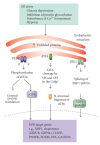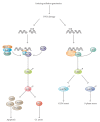Cellular stress responses: cell survival and cell death
- PMID: 20182529
- PMCID: PMC2825543
- DOI: 10.1155/2010/214074
Cellular stress responses: cell survival and cell death
Abstract
Cells can respond to stress in various ways ranging from the activation of survival pathways to the initiation of cell death that eventually eliminates damaged cells. Whether cells mount a protective or destructive stress response depends to a large extent on the nature and duration of the stress as well as the cell type. Also, there is often the interplay between these responses that ultimately determines the fate of the stressed cell. The mechanism by which a cell dies (i.e., apoptosis, necrosis, pyroptosis, or autophagic cell death) depends on various exogenous factors as well as the cell's ability to handle the stress to which it is exposed. The implications of cellular stress responses to human physiology and diseases are manifold and will be discussed in this review in the context of some major world health issues such as diabetes, Parkinson's disease, myocardial infarction, and cancer.
Figures




References
-
- Lockshin RA, Zakeri Z. Programmed cell death and apoptosis: origins of the theory. Nature Reviews Molecular Cell Biology. 2001;2(7):545–550. - PubMed
-
- Lockshin RA, Williams CM. Programmed cell death—I. Cytology of degeneration in the intersegmental muscles of the Pernyi silkmoth. Journal of Insect Physiology. 1965;11(2):123–133. - PubMed
-
- Lockshin RA, Williams CM. Programmed cell death—IV. The influence of drugs on the breakdown of the intersegmental muscles of silkmoths. Journal of Insect Physiology. 1965;11(6):803–809. - PubMed
-
- Lockshin RA, Williams CM. Programmed cell death—V. Cytolytic enzymes in relation to the breakdown of the intersegmental muscles of silkmoths. Journal of Insect Physiology. 1965;11(7):831–844. - PubMed
LinkOut - more resources
Full Text Sources
Other Literature Sources

